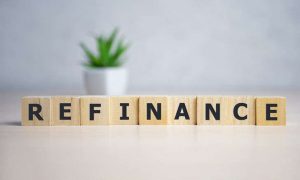Historically low interest rates the last few years have sent homeowners to loan officers in droves to refinance their mortgages, and real estate investors have been right behind them, aiming to lower their monthly costs as well. Some are looking to get a better rate to pay off loans with higher interest rates, or access cash to expand their portfolios.
Rates have drifted up a bit recently, said Jack Snow, Mynd’s senior manager of lending services, but still are near all-time lows.
“They may not be quite at the bottom that they were at six months ago,” says Snow, “but they are still extremely low, so the advantage of refinancing a property now is to lock in a lower interest rate, because, of course, the less interest you’re paying, the better your rate of return.”
The average interest rate on a thirty-year fixed-rate mortgage was at 2.97 percent as of August 2, and the 15-year rate was at 2.28 percent. According to bankrate.com, “Refinancing remains a historically excellent deal.”
In general, rates for investment properties and commercial loans average about a half of a percentage point to a full percentage point higher than loans on a primary residences.
The Advantages of Refinancing Are Many
The New York Federal Reserve reported in March that mortgage originations, including new loans and refinance loans, hit $1.2 trillion in the fourth quarter of 2020, breaking a record that had stood since the historic refinance boom of 2003 (when interest rates dropped twenty percent from 2000). Refinance rates have stayed brisk through the first half of 2021, but some economists expect rates to slow in the second half of the year as the economy rebounds
There are numerous reasons refinancing is attractive. With lower payments, an investor can increase their cash flow. For an investor seeking predictable monthly payments, low rates offer reassurance that costs will remain steady for years to come.
Lenders charge more for loans on investment properties because they represent a higher risk. If an investor has mortgages on their residence and an investment property and can’t pay both, a bank reasons that the investment loan will be a lower priority.
It might also be advantageous for an investor to change the term of her loan. She might want to shorten the term of repayment, meaning she’ll have to make higher monthly payments now, but will pay less in interest because of the shorter term, and free up that money for other purposes sooner.
“Any time you have money this cheap, it frees up new capital to pay off other things that are more expensive,” says Thomas Stepp, Mynd Management’s director of investment services. “You can restart the amortization cycle to increase your cash flow. Or, the motivation can be consolidation. Investors might own multiple properties with individual loans on them, and they can consolidate them into a single product. You might be capped at ten loans per person, but once you consolidate your loans into one, that frees up nine slots, so now you can get the best rates.”
Repayment Costs Depend on Terms of the Loan
Let’s say an investor has a fifteen-year loan of $250,000 at a four-percent interest rate. She will have a monthly payment of $1,849. With a thirty-year loan, she will have a monthly payment of $1,194. The fifteen-year monthly payment is 55 percent higher than the thirty-year for the same amount at an identical rate.
In return for the lower monthly payments on a thirty-year loan, a borrower pays markedly more in interest. Using the same example of a mortgage of $250,000 at a rate of four percent, in a thirty-year loan, she would pay $179,674 in interest by the end of the loan, for a total of $429,674. If she took a 15-year loan, she would pay just $82,860 in interest on the $250,000 principal, totaling $332,860. Assuming the same four-percent rate, that’s only about 46 percent of the interest with a 15-year loan compared to what she would pay over a 30-year term.
Another investor, who wants to keep monthly payments as low as possible, might extend the term of his loan, trading the lower payments for more interest over the long term. Yet another, facing changing monthly payments due to fluctuating interest rates in a variable-rate mortgage, might opt to shift to a fixed-rate mortgage to have more predictable monthly costs.
But it’s not all good news. One disadvantage of refinancing to keep in mind is closing costs. Be prepared to fork over origination fees, appraisal fees and title insurance fees, among other costs. Total closing costs can range from two to six percent of your loan amount, so for a $250,000 mortgage, a borrower can expect to pay from $5,000 to $15,000.
A Cash-out Refinance Enables Investors to Expand Portfolios
Home values are up and mortgage rates are down, which is a perfect formula for investors to draw on the increased value of their homes to expand their portfolios or to make improvements to properties they already own. If they have enough equity, they can do this through a cash-out refinance.
The principle is simple enough: an investor with a loan on a property takes out a new loan of a higher amount, pays off the existing loan, and walks away with the balance as cash. The investor can use those funds to improve a property, for example by adding an addition to a home, finishing a basement and renting it separately, upgrading an HVAC system, or replacing aging cabinets and floors. These steps can allow her to charge higher rents, can increase goodwill with tenants, and can improve the home’s resale value. An entrepreneurial investor could also use the cash to expand her portfolio by making a down payment on a new property.
But there are hurdles to obtaining these loans.
First, it’s harder to qualify. The investor has to have more than twenty-five percent in home equity as well as good credit, typically a score of 680 or higher, but preferably 740 or higher. She will also have to demonstrate cash reserves, generally up to a year’s worth of the payments, on the property being refinanced. Plus, if she has loan balances on properties apart from her residence and the property being refinanced, she’ll have to have reserves equal to up to six percent of the unpaid balance. Finally, there’s a waiting period of six months to refinance after the initial loan closes.
To determine borrowers’ eligibility, lenders use the “loan to value” ratio, or LTV, which is determined by the size of the loan as compared to the value of the home. If an investor is carrying a mortgage of $90,000 on a home that is worth $100,000, for example, the LTV is ninety percent, because the loan makes up ninety percent of the value.
Fannie Mae and Freddie Mac’s guidelines can stipulate seventy to seventy-five percent LTVs. These may be too stringent for some investors seeking a cash-out refinance. Some lenders have more lenient standards, especially after the agency that regulates them placed a tighter cap on the number of investment home mortgages they can purchase.
What Do Investors Need to Know Before Refinancing?
Borrowers do need to be realistic. In any environment, they have to know what their property is worth, and they should be aware of the status of their credit, to avoid any surprises. Banks will order up an appraisal to confirm a property’s value.
Changes to income status brought on by the Covid-19 pandemic may also affect what loans they can qualify for.
“Anyone who is self-employed or non-salaried should talk to their loan consultant to make sure they still qualify,” says Sonia Eckard, a loan consultant with Mynd. “There are a lot of temporary guideline changes because of Covid interruptions. Maybe they don’t qualify based on their tax returns if they are self-employed, or if they get a commission based on sales.”
The post It’s still a great time to refinance investment properties. Here’s why appeared first on Mediafeed.org
Original source: Mediafeed.org






